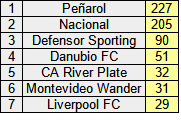Football (or soccer) isn't the big sports code in Australia like it is in so many countries. Clubs are spread across the country and a team from New Zealand has always been a part of the competition. Was has happened is teams have been added names changed and other variances have occurred. The season is held in summer to avoid clashing with more popular codes.
Sydney FC is the most successful club, narrowly ahead of the Melbourne Victory. The Central Coast Mariners north of Sydney are next, followed by Adelaide Utd and the Brisbane Roar.
For points, I went with all sides that played getting something. The A league goes from 16 for the winner, to 14, 12, 10, 8 and then one down to a single point for 14th. For years with less than fourteen teams, the lower scores are not allocated. The top sides go into playoffs to win the grand final, the points are 16, 12, 6 and 2. Slight variances to that for earlier years when there were fewer finalists.
There was a preseason competition for the first four years of competition. Two groups scored 5, 3, 2 and one point. The four finalists 6, 4 and two sides with 2 points.
The A league has the same rankings as the overall points above except for Adelaide swapping places with the Central Coast club. Melbourne City don't feature here but the won three consecutive titles from 2021 to 2023. That run was ended in 2024 by the Mariners.
The preseason two group competition was fairly evenly spread due to the few games played. The Central Coast was the most successful club, ahead of three others which tied.
The finals had Adelaide as the top club along with the Mariners. Melbourne Victory and the Perth Glory had did quite well.
All put together, the clubs are below. The grand total is shown for each club, divided into regions with a ranking number (Rk) which gives their place compared to all the other clubs.
The state of New South Wales is the leader with 40.1% of all points. Victoria is next with 22.6% I combined Queensland with New Zealand for third and 19%%. Lastly the West with 18.3%.
I will explain the symbols that come after some of the names below. Melbourne City was the Melbourne Heart, the Brisbane Roar was Queensland Roar, the Wellington Phoenix previously were in Auckland and were the NZ Knights. Finally, the Gold Coast and North Queensland clubs folded after three and two years respectively.






















